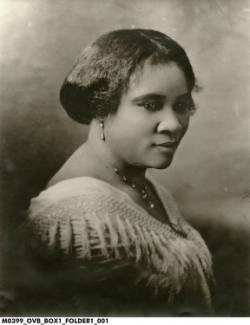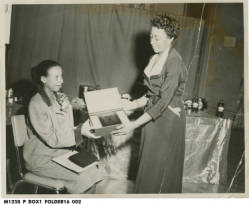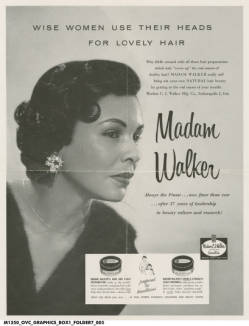This post is in conjunction with our Madam C.J. Walker program on June 21, 2023 with Rick Feingold (Professor of American Business History at Bergen Community College) on the life of Madam C.J. Walker. All images taken from the Indiana Historical Society.
Born Sarah Breedlove on December 23, 1867 to parents Owen and Minerva Breedlove, two formerly enslaved people in Louisiana. Sarah was their first child to be born free after the Emancipation Proclamation was signed. In 1872, Sarah’s mother died of Cholera followed by her father’s passing a year later. Orphaned at 7, Sarah and her sister Louverna moved to Mississippi where Sarah began working. Exhausted from living with her abusive brother in law Sarah at 14 married her first husband Moses Williams. Their daughter Leila Williams was born in 1885 and two years later Moses suddenly died. Sarah and her daughter left for St. Louis to find work after her brothers’ success as barbers.

“I had to make my own living and my own opportunity. But I made it! Don’t sit down and wait for the opportunities to come. Get up and make them.“
In the 1890s, Sarah began to suffer from a scalp aliment which caused her to start losing her hair. She starting experimenting with homemade remedies as well as store bought solutions to see what would help. Her life changed drastically when she found Annie Turbo Malone’s hair products. She later joined Malone’s team as a saleswoman. After a year, Sarah moved to Denver with her daughter and married Charles Joseph Walker, an advertiser. During 1905, Sarah renamed herself “Madam C.J. Walker” and with $1.25 started her own business, Madam C.J. Walker’s Wonderful Hair Grower. Over the next few years, Walker traveled throughout the southern states, demonstrating her products at local churches. Charles Joseph Walker assisted his wife in creating a mail order business along with early advertisements. Additionally, Madam Walker created her own marketing strategies.
The two left Denver in 1908 and relocated to Pittsburgh. In Pittsburgh, Walker founded a school, The Leila College of Beauty Culturists, as a training school for her employees to learn about the product.

image of product demonstration
After Sarah and Charles divorced in 1910, Sarah moved to Indianapolis which was the largest manufacturing city in the country. Here Walker built her factory, a hair and nail salon, and another training school which included a lab for testing new products. Walker and her staff including Freeman Ransom, Robert Lee Brokenburr, Alice Kelly and Marjorie Joyner assisted in the growth of her business. At the time, The Walker Manufacturing Company employed predominantly female employees. The Walker method consisted of shampoo and a pomade to help grow hair. It also had women brush their hair strenuously and apply iron combs to shape hair from brittle texture to soft and flowing.

The height of the company was during 1911-1919. Walker and her team placed advertisements in the major black magazines and newspapers along with travel shows throughout the US. In addition to showcasing her hair products, the team would also have classes focused on promoting independence for women. These classes ranged from topics including financial independence, budget planning and how to start your own business. As the business grew, so did the need for representation. The Walker company created their own union, Madam Walker Union for the sales representatives and the beauty culturist. The union was broken up between state and local chapters around the country. In 1917 the union had its first national convention at the Union Baptist Church in Philadelphia.

Aside from being known for her company, Madam C.J. Walker was a fierce activist. In 1917, Walker wrote to President Woodrow Wilson to urge him to make lynching a federal crime. The Walker company provided support for soldiers overseas during World War I as part of the company’s mission to help serve the black community. Walker herself, contributed to the building of the YMCA for black people in Indianapolis, paid the tuition for six black men to attend The Tuskegee Institute, and donated 5,000 dollars to the NAACP. Before she died, Walker changed her will so that two-thirds of her estate went on to charity along with individuals and organizations. After being denied the opportunity to attend school Walker made donations to her friends Charlotte Hawkins Brown and Mary McLeod Bethune schools so that more children could get an education.
Madam C.J. Walker died on May 25th, 1919 from kidney failure. Her legacy resonates strongly today as she remains a highly influential role model to women. The Walker brand continues to make products that are carried at Sephora and Walmart.
If you are interested in learning more about Madam C.J. Walker, you can visit her home of Villa Lewaro in Irvington New York. Walker’s personal papers are archived at the Indiana Historical Society and some of the material is available online to search. Also in Indianapolis is the Madam C.J. Walker Theater Center which was the original factory used by the Walker company.


Recent Comments